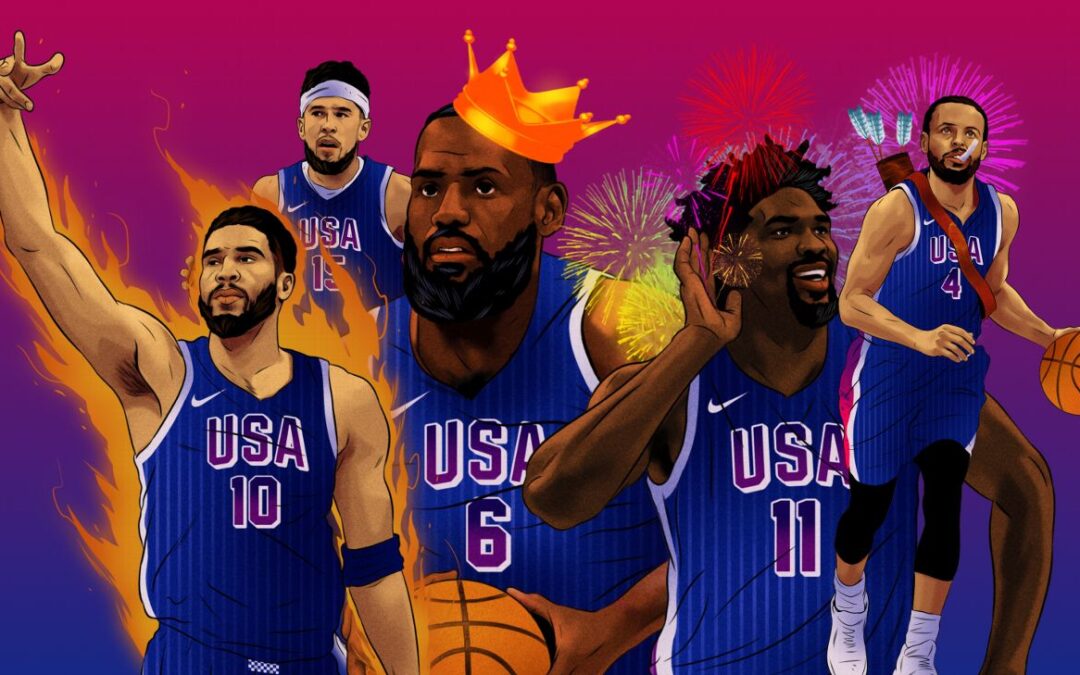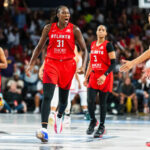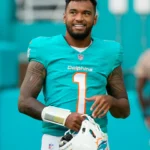
As the 2024 Paris Olympics basketball tournament progresses to its exhilarating quarterfinals stage, the intensity reaches new heights. This year’s competition is shaping up to be one of the most thrilling ever, with a wealth of talent gracing the courts. Featuring a staggering lineup of NBA stars and exceptional international players, this tournament promises unforgettable moments. Let’s dive into the strengths and weaknesses of each remaining team as they vie for a coveted spot on the Olympic podium.
USA: The Unstoppable Force
Strengths: A Depth of Talent and Athleticism
The United States team stands out with its unparalleled depth and sheer athleticism. Led by basketball legends like LeBron James and Kevin Durant, the American squad boasts an impressive roster filled with talent. James, with an average of 14.3 points and 7.3 assists, and Durant, shooting an impressive 64%, are at the forefront of this powerhouse team. The second unit, featuring players such as Derrick White, Bam Adebayo, and Anthony Davis, would likely still be a formidable force even on its own.
In pool play, the Americans showcased their prowess with dynamic perimeter shooting and exceptional rim protection, thanks to Adebayo and Davis. Their transition game is explosive, making them a daunting opponent on the fast break.

Team USA, led by LeBron James, Kevin Durant and Anthony Davis, is averaging 100-plus points per game, the first time since the Dream Team in 1992. (AP Photo/Mark J. Terrill)
Weaknesses: Rebounding and Half-Court Offense
Despite their offensive firepower, the Americans struggle with rebounding and half-court offense. They rank fourth in rebounds per game with 41, trailing behind Australia, Serbia, and South Sudan. Although they’ve consistently scored over 100 points per game, a slower tempo exposes vulnerabilities in their offense.
Canada: A Rising Contender
Strengths: Top-Tier Talent and Wing Depth
Canada’s roster is brimming with NBA talent, featuring 10 current NBA players. The team’s strength lies in its top-end talent and wing depth. Shai Gilgeous-Alexander, possibly the standout player of the tournament, excels in clutch moments, averaging 19.0 points per game. He’s closely followed by RJ Barrett, who leads the team with 21.0 PPG. Wing players like Dillon Brooks and Luguentz Dort provide crucial 3-and-D contributions, adding depth to Canada’s lineup.
Weaknesses: 3-Point Shooting and Rebounding Issues
Canada faces challenges with inconsistent 3-point shooting, hitting just 33% from beyond the arc. Additionally, their rebounding has been a weak point, ranking last in the tournament with an average of 33 rebounds per game. The team’s reliance on isolation plays contributes to a lower assist rate, further impacting their offensive efficiency.

Team Canada is led by Shai Gilgeous-Alexander and RJ Barrett, who lead the team with 19 and 21 points per game, respectively. (Photo by Jesse D. Garrabrant/NBAE via Getty Images)
Germany: The Team with Unmatched Chemistry
Strengths: Defensive Dominance and Offensive Versatility
Germany’s strength lies in its exceptional team chemistry and defensive prowess. With a defense that has yet to concede more than 77 points in a game, the Germans demonstrate remarkable cohesion. Guard Dennis Schroder leads the team in assists, averaging 9 per game, while the offense benefits from multiple scoring threats. Franz Wagner’s impressive 21.7 points per game rank him third in the Olympics, highlighting Germany’s offensive depth.
Weaknesses: Rebounding and 3-Point Shooting
Despite their size, Germany struggles with rebounding, averaging just 34.7 rebounds per game. The Wagner brothers, vital for both ends of the court, are prone to foul trouble, which can impact the team’s effectiveness. Additionally, Franz Wagner’s poor 3-point shooting—21%—diminishes the team’s perimeter threat.

Dennis Schroder leads all Olympic players with nine assists per game and averaging 19.7 points. (AP Photo/Mark J. Terrill)
Serbia: A Blend of Size and Skill
Strengths: Elite Playmaking and Offensive Efficiency
Serbia’s standout feature is its size and the extraordinary playmaking abilities of Nikola Jokic. Serbia excels in ball movement, leading the tournament with 25.7 assists per game. Bogdan Bogdanovic is another key player, contributing 19 points per game with a 54% shooting rate. Overall, Serbia boasts the second-best offense in the tournament, showcasing their skill and efficiency.
Weaknesses: Speed and Versatility Concerns
Serbia’s pace and versatility are areas of concern, particularly in high-speed games. They’ve struggled with defending the 3-point line and have been inefficient from beyond the arc themselves, shooting under 33% in Paris. Their average speed and limited adaptability can be a disadvantage against faster, more versatile teams.

Nikola Jokic leads all Olympic players with 11 rebounds per game and is tied for first with two double-doubles. (Photo by Jesse D. Garrabrant/NBAE via Getty Images)
France: A Powerhouse in the Paint
Strengths: Dominant Centers and Experienced Squad
France benefits from the exceptional skills of centers Victor Wembanyama and Rudy Gobert. Wembanyama, averaging 17 points and 10.7 rebounds, has been a standout performer, while Gobert leads in blocks with 2.7 per game. The team’s experience is a significant asset, with many players having been part of the 2021 silver medal-winning squad.
Weaknesses: Guard Play and Rebounding Woes
Despite their strong frontcourt, France struggles with guard play, particularly from Evan Fournier, who is shooting just 32% from the field. The team also faces difficulties on the boards, ranking poorly in rebounding with an average of 36.7 rebounds per game. Additionally, their offense is inconsistent, averaging just 81 points per game.

Victor Wembanyama is having a great Olympics and leads France in points (17), assists (3) and rebounds (10.7) per game. (Photo by Gregory Shamus/Getty Images)
Australia: The Backcourt Advantage
Strengths: Strong Backcourt and Rebounding
Australia’s backcourt, featuring NBA guards like Josh Giddey, Patty Mills, Dyson Daniels, and Josh Green, is a major strength. When in rhythm, the team excels in generating and executing scoring opportunities, especially in the paint. Australia’s rebounding, averaging 41.3 rebounds per game, is the second-best among remaining teams, providing them with an edge in possession.
Weaknesses: Offensive Inconsistencies
Australia’s offensive performance is inconsistent, with a 38.7% shooting rate from beyond the arc and a troubling 63.5% from the free-throw line. Turnovers have also been an issue, particularly with lead playmaker Giddey averaging 4.3 turnovers per game.
Brazil: Dominance in the Paint
Strengths: Offensive Rebounding and 3-Point Shooting
Brazil excels in offensive rebounding, leading the tournament with an average of 13 offensive boards per game. Their 3-point shooting is also impressive, with a tournament-leading 45% shooting rate from beyond the arc. This ability to dominate the glass and shoot efficiently from long range provides Brazil with a solid foundation.
Weaknesses: Scoring and Turnover Issues
Despite their strengths, Brazil’s offense has been anemic, averaging just 80.3 points per game, the second-lowest among the remaining teams. Turnovers are a significant problem, with Brazil leading the tournament with 17.3 turnovers per game, which hampers their overall performance.
Greece: The Antetokounmpo Effect
Strengths: Giannis Antetokounmpo’s Brilliance
Greece’s primary strength is the extraordinary performance of Giannis Antetokounmpo. Averaging 27 points and 7.7 rebounds per game, Giannis has been a dominant force. Greece also excels in ball movement, averaging 21.3 assists per game, with Nick Calathes contributing significantly in this regard.

Giannis Antetokounmpo leads all Olympic players in points per game (27) and leads Greece in rebounds (7.7) and is second in assists (3.7). (AP Photo/Mark J. Terrill)
Weaknesses: Poor Shooting and Reliance on Antetokounmpo
Greece struggles with shooting accuracy, ranking as the worst 3-point shooting team with just 30% and the third-worst free-throw shooting team at 69%. Their offense heavily relies on Antetokounmpo, allowing opposing defenses to focus on neutralizing him, which leads to Greece averaging the fewest points (77.7) of any remaining team.
As the quarterfinals approach, each team brings its own set of strengths and weaknesses to the court. With a mix of powerhouse players and emerging talents, the path to Olympic gold promises to be a thrilling journey. Stay tuned as these elite teams battle for glory in the heart of Paris!
















